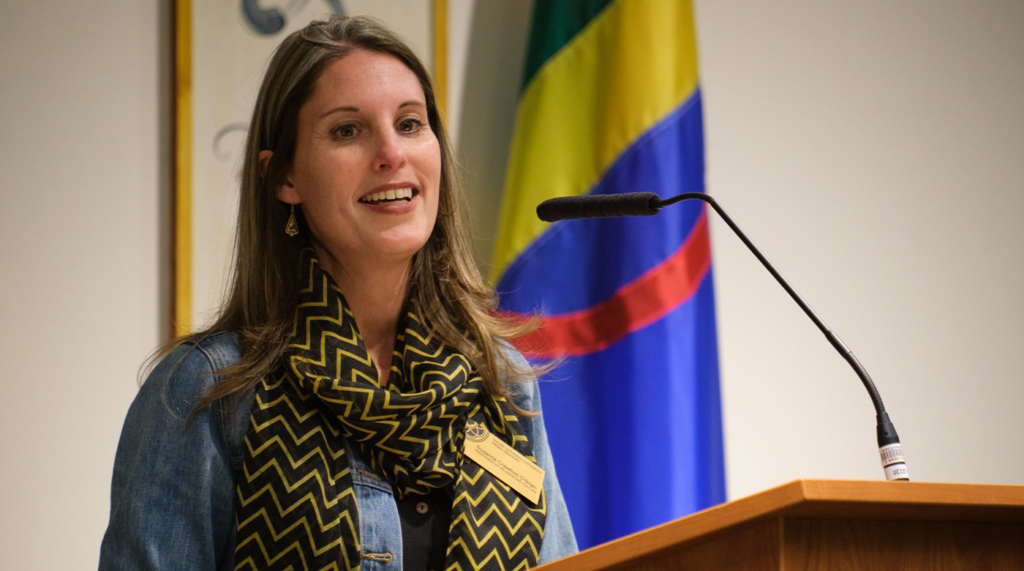Page 20 • (241 results in 0.073 seconds)
-
church. In 1975, she began teaching human anatomy and physiology laboratories at PLU and continued in that position until she retired in 2002. She initiated and guided the human cadaver dissection program at PLU, working with the University of Washington School of Medicine to establish protocols. Matthias is survived by her husband, two sons and five grandchildren. VOLUME 6, ISSUE 3 RESOLUTE is Pacific Lutheran University’s flagship magazine, published three times a year. EDITORIAL OFFICES PLU, Neeb
-
the manager, Fernando Duran, who is passionate about making the farm healthy for flowers and workers. He told me the farm uses a quarter of the pesticides it used 20 years ago. In an effort to eliminate pesticides, Duran said, a researcher at LatinFlor found a natural biological control for a stubborn pest, the leaf miner. The scientist found the wasp is a natural enemy of the insect, attacking its larvae. He then developed a vacuum that is used to suck the dead insects off every plant. “I’m happy
-
Plant Sciences at Somerville College. Each week I was assigned an essay topic and given a list of readings pertaining to that topic. After researching the essay topic, I then wrote an essay of approximately 2,000 to 2,500 words, answering the prompt. For each essay I spent about 10–20 hours researching the topic prior to writing the essay. After writing each essay I would email it to my professor, and we would discuss it at our next meeting. My professor and I met for an hour once a week for the
-
Extracts from Ribes Species Native to the Pacific NorthwestCenafer Carino, Senior Capstone Seminar Two species from the Ribes genus native to the Pacific Northwest were targeted to extract and characterize antimicrobial compounds. The stems and bark of R. Sanguineum and R. Lacustre were cut into pieces and blended before being air-dried. Air-dried bark and stems of each plant were refluxed with petroleum ether and then methanol. Crude extracts were obtained after rotary evaporation and high vacuum
-
that ask good questions.Olympia Centennial Elementary How Does Soap Water Affect Plant growth in our Environment?2 LohtihRalph MorashScholastic Books This Box RocksProjects that ask good questions.OlympiaMcLane Elementary Building Beaches2 AlexandriaRalph MorashScholastic Kits Dinosaur DigProjects that ask good questions.Peninsula Artondale ElementaryHow Does the Type of Sugar Affect the Crystal?4 AustinRalph MorashScholastic Books This Box RocksProjects that ask good questions.Clover ParkOakbrook
-
is connected to the animal that their clan’s masks depict. The animal is involved in the founding myths of the clans and members of a clan cannot kill their clan’s animal. Masks are named after the animal a mask represents, prefixed with the word “wan-”. For example, a gazelle mask would be known as wan-nyaka. The masks are commonly accompanied by a costume made of blackened fibers from the hibiscus plant called a bindu. Young men who are educated in the meanings of the mask are those chosen to
-
. Major and Hidden Sources of Gluten: Major Sources of Gluten Barley Bran Couscous Flour (wheat) Kamut Malt Matzo Pasta Rye Seitan Semolina Soy Sauce Spelt Sprouted wheat or barley Teriyaki Sauce Triticale Udon Wheat Hidden Sources of Gluten Beer Brewer’s yeast Coloring Fillers Flavorings Graham flour Hydrolyzed plant protein Hydrolyzed vegetable protein Mono- and diglycerides Monosodium glutamate Spices Textured vegetable protein Food Allergies vs. Food IntolerancesFood Allergies involve the immune
-

applied field research. It helps our students become systems thinkers, to understand that a single issue or problem can—and must—be seen from a variety of perspectives. It challenges students to understand the complexity inherent in human relationships with places, and how we need to work with all the living communities of that place—plant and animal and mineral as well as human—in our restoration efforts.Let's keep the conversation going! Read the additional Bjug Day Q&A's Bjug Day Q&A
-

had never done anything remotely medical until this internship,” she said. “It’s really more the anatomy, physiology side of it that I really like.”Haley Hurtt '18 Photo by Oliver Johnson '18 This summer, English literature major Haley Hurtt ’18 became well acquainted with her U.S. senators. Or at least their voicemails. Hurtt was an intern for the global poverty nonprofit, The Borgen Project. She was responsible for calling her senators every week and raising at least $500, but her main job was
-
nursing degree from PLU, and will not be able to sustain/obtain licensure in the State of Washington and/or other states. Entry-Level M.S.N. Pre-Licensure and Care and Outcomes Manager Curriculum 56 semester hours (pre-licensure) 31 semester hours (post-licensure, at minimum) Prerequisite Courses Introductory Statistics (including inferential and descriptive) (4) Human Anatomy and Physiology I (with lab) (5) Human Anatomy and Physiology II (with lab) (5) Introductory Microbiology (with lab) (4
Do you have any feedback for us? If so, feel free to use our Feedback Form.


